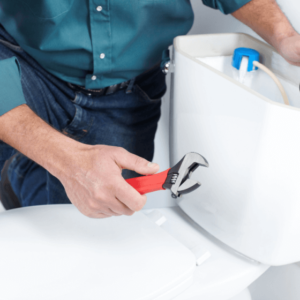When painting, you can use the best paint and brushes money can buy, but if you don’t properly mask the surfaces that you don’t want painted you won’t get the professional-looking results you desire. Use painter’s tape along wall and ceiling edges, on fixtures, and around trim and molding to keep clean, sharp paint lines and to protect surfaces from unwanted drips and splatters.
Why Use Painter’s Tape?
For almost a century, masking tape has been used to cover and protect adjacent surfaces when painting. More recently, painter’s tape has proven to be a more effective masking tool for painting both internal and external walls.
Painter’s tape is more effective at reducing paint bleed, and it is easier to remove without marring the surface underneath than traditional masking tape. Painter’s tape is more flexible than masking tape and doesn’t bubble up when it is applied. Air bubbles can allow paint to seep under and ruin your work. It stays adhered to the surface, leaving a clean paint line between surfaces. Masking tape can also leave clean lines like painter’s tape, but usually isn’t as reliable. It can often pucker up when using latex paints, which allows paint to seep under. Also, masking tape can often leave a sticky residue if left on for too long; it must be removed as soon as possible. Masking tape is usually a bit cheaper, but just doesn’t provide the advantages of a high-quality painter’s tape such as Scotch Blue painter’s tape or Frogtape painter’s tape.

Painter’s tape comes in a variety of widths and lengths and is made for select applications on particular surfaces. Before starting your paint project, make sure you purchase the appropriate tape for the job. The tape’s adhesion level is important. Some tapes are better for carpeted surfaces, for example, while others may be better for wood. Painter’s tape can also be used for decorative painting techniques, such as painting stripes. See the project How to Paint Wall Stripes for detailed tips on how to use painter’s tape to create striped walls. Check labels for best use, many tapes will be labeled “multi-surface.” If you need help ask an expert at your local True Value hardware store.
How to Use Painter’s Tape
Step 1: Test the Tape
Check that you have the right tape for the job by testing it in an inconspicuous area. Press a piece onto the surface and then remove it. See if it damages the surface by removing the existing paint or finish; be sure that it doesn’t stain as well. If either of these things happens, the tape’s adhesion level might be too strong for the surface. Also, check that the tape adheres effectively to the surface. If it doesn’t, you will need tape with a higher-grade adhesion.
Step 2: Prepare the Work Area
Before starting any paint project, remove furniture from the room in which you’re working, or place it in the center of the room and cover it with drop cloths. Place drop cloths or tarps on the floor and remove fixtures, window coverings, switch plates and outlet covers. You will want to cover the outside edge of anything you couldn’t remove with painter’s tape. See Step 3.
Outside, use drop cloths to cover cars, patio furniture, shrubs and anything else you don’t want splattered. Remove all screens, light fixtures, plumbing outlets, electrical covers, shutters and address numbers/placards. Again, you will want to cover the edges of anything you couldn’t remove with painter’s tape.
Properly cleaning surfaces is necessary for both painter’s tape and paint adhesion. Painter’s tape won’t adhere well to dirty or damaged areas and poor adhesion can lead to paint infiltrating under the tape. Use a sponge to wipe down all surfaces with mild detergent and water, and allow it to dry.
Step 3: Apply Tape

Pull or cut a length of tape from the roll a few feet at a time and carefully apply it on the surface you are masking. Be careful that you don’t stretch the tape as you apply it to avoid breaks or poor adhesion. Press and smooth the tape down on the surface as you apply, so it makes even contact. Use a putty knife or similar tool to press the tape down and ensure it has adhered and formed a tight seal along edges and in the contours of the surface.
Helpful Tip
When you start painting, brush a bit of paint along the tape edge to create an additional seal against paint bleeding under the tape.
Step 4: Prime and Paint

Choose a quality primer and paint, such as the True Value EasyCare line of paint products. Typically, one gallon of paint will cover 350 to 400 square feet. Buy more than you think you need; you can always use the extra for touch-ups. Apply True Value EasyCare Ultra Premium Interior Paint with a brush or roller. See Paint a Room for detailed painting steps.
Safety Alert!
Open the windows to make sure you’re priming and painting in a well-ventilated area.
Step 5: Remove Tape and Clean Up
When done painting, remove the tape after the last coat has dried. This takes usually 30 minutes to an hour. Remember that the longer it stays on, the harder it is to remove and can lift your paint!

Helpful Tips
Pull it off at a 45-degree angle to avoid removing any paint from the painted surface. Also, pull it gently at a constant and controlled rate to avoid removing paint (happens when pulling too quickly) or leaving adhesive on the masked surface (happens when pulling too slowly). If you see a layer of paint that looks like it will lift away along with the tape, use a putty knife to lightly score the edge where the tape meets the paint.
Keep the room or work area temperature in mind when removing tape. Extreme temperatures can affect how easily the tape comes off. Cold temperatures can make the tape crack and break and come off unevenly while hot temperatures can make the tape stickier, leaving adhesive behind.
Don’t forget to pick up your drop cloths and clean your brushes and roller covers with soap and water. Hang brushes to dry. Close up cans of unused paint and store them away. Dispose of used paint and cans appropriately.
That’s it! Now you know how to use painter’s tape properly on all of your paint projects.
Project Shopping List
Here’s what you’ll need to complete this project successfully.












